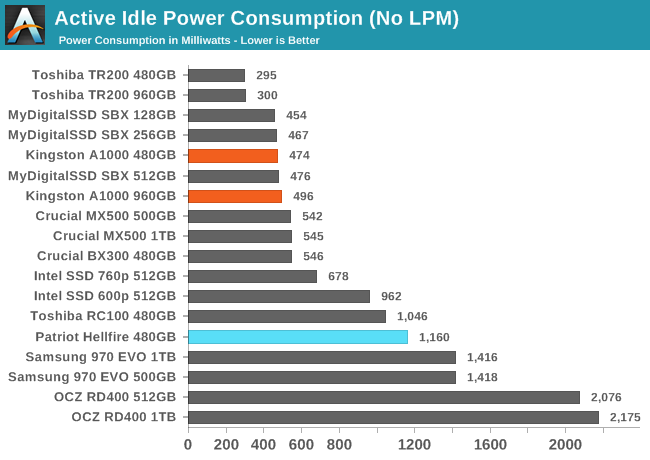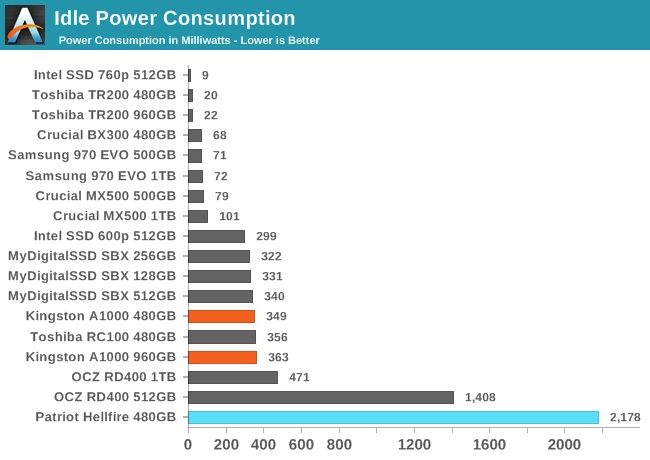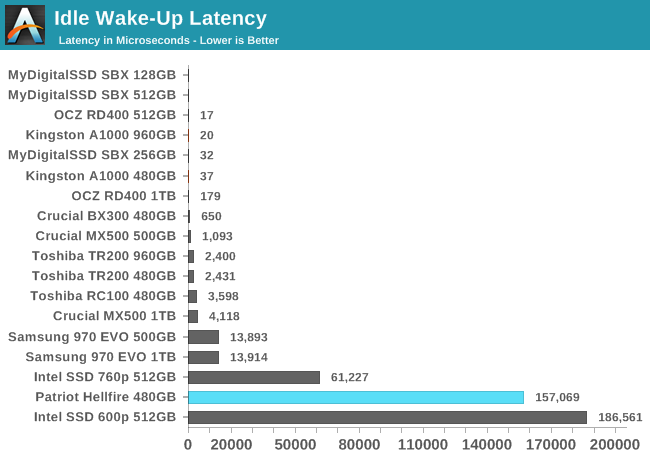The Kingston A1000 NVMe SSD Review: Phison E8 Revisited
by Billy Tallis on July 2, 2018 8:00 AM ESTPower Management Features
Real-world client storage workloads leave SSDs idle most of the time, so the active power measurements presented earlier in this review only account for a small part of what determines a drive's suitability for battery-powered use. Especially under light use, the power efficiency of a SSD is determined mostly be how well it can save power when idle.
For many NVMe SSDs, the closely related matter of thermal management can also be important. M.2 SSDs can concentrate a lot of power in a very small space. They may also be used in locations with high ambient temperatures and poor cooling, such as tucked under a GPU on a desktop motherboard, or in a poorly-ventilated notebook.
| Kingston A1000 NVMe Power and Thermal Management Features |
|||
| Controller | Phison PS5008-E8 | ||
| Firmware | E8FK11.G | ||
| NVMe Version |
Feature | Status | |
| 1.0 | Number of operational (active) power states | 3* | |
| 1.1 | Number of non-operational (idle) power states | 2 | |
| Autonomous Power State Transition (APST) | Supported | ||
| 1.2 | Warning Temperature | 81 °C | |
| Critical Temperature | 85 °C | ||
| 1.3 | Host Controlled Thermal Management | Not Supported | |
| Non-Operational Power State Permissive Mode | Not Supported | ||
The Kingston A1000 supports the typical NVMe 1.2 feature set for power and thermal management. The power state table is a bit odd, with the power for all three active states listed as the same. The two idle states are the same as on the MyDigitalSSD SBX for both power limit and the entry/exit latencies.
| Kingston A1000 NVMe Power States |
|||||
| Controller | Phison PS5008-E8 | ||||
| Firmware | E8FK11.G | ||||
| Power State |
Maximum Power |
Active/Idle | Entry Latency |
Exit Latency |
|
| PS 0 | 7.9 W | Active | - | - | |
| PS 1 | 7.9 W | Active | - | - | |
| PS 2 | 7.9 W | Active | - | - | |
| PS 3 | 100 mW | Idle | 1 ms | 1 ms | |
| PS 4 | 5 mW | Idle | 400 ms | 90 ms | |
Note that the above tables reflect only the information provided by the drive to the OS. The power and latency numbers are often very conservative estimates, but they are what the OS uses to determine which idle states to use and how long to wait before dropping to a deeper idle state.
Idle Power Measurement
SATA SSDs are tested with SATA link power management disabled to measure their active idle power draw, and with it enabled for the deeper idle power consumption score and the idle wake-up latency test. Our testbed, like any ordinary desktop system, cannot trigger the deepest DevSleep idle state.
Idle power management for NVMe SSDs is far more complicated than for SATA SSDs. NVMe SSDs can support several different idle power states, and through the Autonomous Power State Transition (APST) feature the operating system can set a drive's policy for when to drop down to a lower power state. There is typically a tradeoff in that lower-power states take longer to enter and wake up from, so the choice about what power states to use may differ for desktop and notebooks.
We report two idle power measurements. Active idle is representative of a typical desktop, where none of the advanced PCIe link or NVMe power saving features are enabled and the drive is immediately ready to process new commands. The idle power consumption metric is measured with PCIe Active State Power Management L1.2 state enabled and NVMe APST enabled if supported.


The active idle power consumption of the Kingston A1000 is among the best we've seen from a NVMe drive, and is comparable to typical SATA SSDs. Enabling sleep states helps a bit, but leaves the A1000 drawing far more power than SATA drives and the best NVMe drives. However, this is still a substantial improvement over Phison's previous generation E7 controller. The MyDigitalSSD is ahead of the A1000 by a few mW in both cases, but the difference is too small to be of significance.

Like the MyDigitalSSD SBX, the Kingston A1000 has minimal wakeup latency in practice on our testbed because it isn't actually able to reach the advertised power levels of either idle power state. When the controller never goes to sleep in any meaningful way, wake-ups tend to be very quick.










26 Comments
View All Comments
romrunning - Monday, July 2, 2018 - link
Any NVMe drive that doesn't beat the Intel 600p in every category shouldn't be made. I really wish all mfgs would keep NVMe drives to at least PCI x4 & 8 channels with a minimum performance level that is much higher than SATA. The bar for the next tech level of storage products should be at a higher level than the previous.Forget the low-end marked for NVMe. SATA can easily take care of any needs there.
peevee - Monday, July 2, 2018 - link
Given that only Samsung barely saturates PCIex2, and only on artificial tests, at this point even x4 is useless, let alone x8. They'll need many more channels.Actually, I'd prefer x1 for ultra-low-power, if it is fully saturated in more or less real-life tests (like AT's "Light"), vs x4 which only saturates 1/10th of x1 capacity.
romrunning - Tuesday, July 3, 2018 - link
I was thinking more along the lines of every mfg creating NVMe drives have to attain to a minimum performance level. It becomes easier to understand what is higher-performing from the end-user's perspective. So if NVMe's minimum performance level is 2x SATA, then anytime you see NVMe you know it's better than SATA. Too bad whatever storage consortium finalized specs for NVMe didn't require min perf levels for storage.It's annoy to me when these mfgs put out "new" drives that don't exceed the older tech.
FunBunny2 - Monday, July 2, 2018 - link
" I really wish all mfgs would keep NVMe drives to at least PCI x4 & 8 channels with a minimum performance level that is much higher than SATA. "some wag put it, "you sell the sizzle, not the steak".
Gunbuster - Tuesday, July 3, 2018 - link
Okay Kingston, reviews are done, feel free to swap in cheaper/slower NAND chips. ;)Ratman6161 - Tuesday, July 3, 2018 - link
In the ATSB Heavy Data Rate chart, for the 1TB 970 EVO, I think you have the full and empty numbers transposed. I.e. you show 525 empty and 635 full. I assume that should be 635 empty and 525 full?Billy Tallis - Tuesday, July 3, 2018 - link
They're not transposed. I'm not sure what happened with those test runs, but I'm re-running them. I do know that Samsung drives lie about when they've finished a secure erase, so it's possible the "empty" drive test run was still working on an erase operation in the background even though I try to ensure all drives have plenty of idle time to finish cleaning up after they claim to be done erasing.leexgx - Wednesday, July 4, 2018 - link
Surprised it works like that when using secure erase, zapping page area and all NAND chips should not take long to do, also what can i use to use secure erase on all drives (seagate own tool seems to lack it, it has full erase but it's not secure erase and it killed my seagate firecuda doing it)SanX - Tuesday, July 3, 2018 - link
Everyone here knows that in the shops the average Joe will see on the product tag "Sequential Read 1500 MB/s" which is plain lie and conveniently keeps mum about this. Which test gives 1500, show me? At best 2-3 times less.This site degraded long ago to serve salespeople.
rocky12345 - Wednesday, July 4, 2018 - link
Great review but this drive does seem rather unimpressive for sure. It acts like it doe snot have a dram cache at all since most if it's scores are well below the mark. I like Kingston for their memory products which work well in the systems I build for my clients. These NVMe drives that are considered lower end give a false picture of great speed and performance because NVMe drives are known for their great performance level. Then you get these drives trying to break into this sector and do not perform any where close to what you would expect from a NVMe drive. Heck my samsung 860 Pro 512GB Sata SSD can get better numbers in a lot of the tests done in the review than these cheap low end NVMe drives and it is only based off of the Sata port and limited to a max 600MB's from the port itself that is kinda sad if you think about it really.